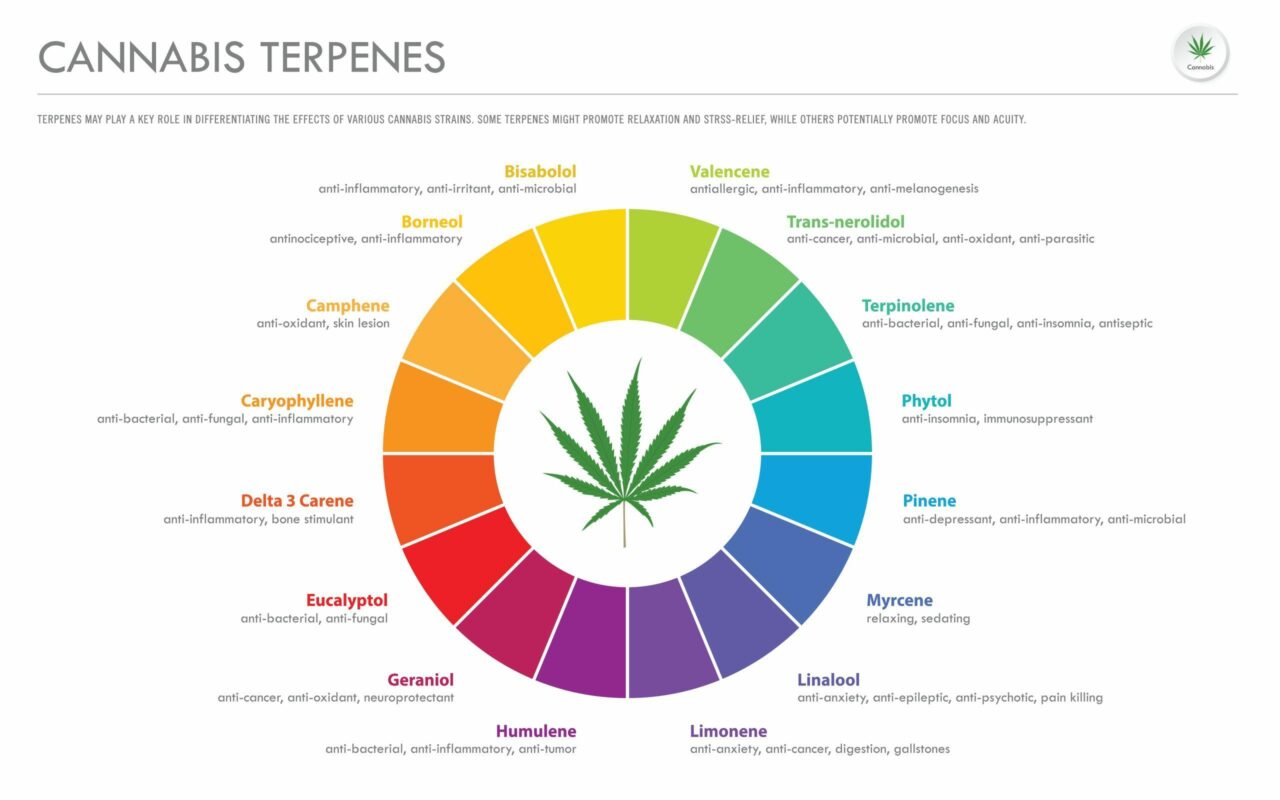ThHave you ever opened up a fresh jar of bud to give it a smell, and had the aroma take you way back to a nostalgic event or memory in your life? This is likely because whichever smell was associated with your past memory shares similar terpenes with your cannabis!
So what exactly is a terpene?
Trichomes, which are essentially tiny, mushroom-shaped growths containing a sticky resin filled with cannabinoids inside the heads and stalks, typically cover most types of cannabis flowers. One of the main functions of this resin is to produce certain aromas and essential oils to repel insects and other natural predators. Many herbivores find these aromas unpalatable, but to human beings they can share the same smells as pine needles, mangos, apples, pepper, mints, cloves, etc.
What else can terpenes do?
Terpenes can also invoke therapeutic effects, which can be amplified when paired with cannabinoids. Terpenes assist cannabinoids with entering the bloodstream and help them interact with the endocannabinoid system. This process is called the Entourage Effect. The different terpene-cannabinoid relationships are also what allows each strain of cannabis to have its own specific psychoactive and medicinal effects. For example, one strain may contain high amounts of limonene, which typically helps to elevate one’s mood and relieve stress by increasing your brain’s serotonin levels, and can also help to treat depression, cancer, inflammation, and pain!
Here are some terpenes and their related functions:
α Pinene
α Pinene accounts for cannabis’ familiar odor, often associated with pine trees and turpentine. α Pinene is the most common naturally occurring terpenoid and acts as both an anti-inflammatory and a bronchodilator.
Linalool
Linalool has a floral scent reminiscent of spring flowers, but with spicy overtones. It possesses sedative properties and is an effective anxiety and stress reliever. It has also been used an analgesic and anti-epileptic.
Myrcene
Myrcene is the most prevalent terpene and is found in most varieties of cannabis. These concentration dictates whether a strain will have an Indica or Sativa effect. Strains containing over 0.5% of myrcene produce a more sedative high, while strains containing less than 0.5% myrcene have an energizing effect. In addition it is also present in thyme, hops, lemongrass, and citrus, and is used in aromatherapy.
Limonene
Limonene is a dominant terpene in strains with a pronounced Sativa effect. It is also found in the rinds of citrus fruits. Limonene aids in the absorption of other terpenes through the skin and mucous membranes, and has been used to treat anxiety and depression.
Ocimene
Ocimene is frequently used in perfumes for its pleasant odor. In nature, this terpene contributes to a plant’s defenses and possess antifungal properties.
Terpinolene
Terpinolene has been shown to exhibit antioxidant and anticancer effects in rat brain cells. Studies with mice show that terpinolene has a sedative effect when inhaled. In addition, terpinolene is responsible for many of the floral notes found in Jack Herer varieties.
Terpineol
Terpineol is known for its pleasant smell and is often used in soaps and perfumes. It is known to have relaxing effects.
Valencene
Valencene is present in Valencia oranges and contributes to cannabis’ citrus aroma.
β Caryophyllene
β Caryophyllene is the only terpene known to interact with the body’s endocannabinoid system (CB2). It produces anti-inflammatory and analgesic effects.
Geraniol
Also present in geraniums, geraniol emits a rosey scent that makes it a popular perfume additive. It is an effective mosquito repellent and shows a potential protective effect against neuropathy.
Humulene
α Humulene contributes to the “hoppy” aroma of cannabis. This terpene acts as an appetite suppressant and exhibits potent anti-inflammatory activity.
List of Secondary Terpenes Found in Cannabis:
- Phellandrene
Phellandrene is commonly found in the essential oil of plants in the eucalyptus genus. Its smell is reminiscent of peppermint, with a slight citrus tone. Recent research shows that phellandrene possesses antidepressive effects.
- Carene
Carene has a sweet, pungent odor and is a main constituent of pine and cedar resin. It is used to dry out excess body fluids, such as tears, mucus, and sweat.
- Terpinene
Terpinene is used as a fragrant additive in both the cosmetic and food industries.It is also considered to be a well-tolerated additive in the pharmaceutical industry. It has very strong antioxidant properties.
- Fenchol
Fenchol is found in basil and is used extensively in perfumery. It is known to exhibit antibacterial properties.
- Borneol
Borneol has a menthol aroma and is used as a calming sedative. It is also beneficial for combating fatigue and recovering from stress or illness. Borneol exhibits both anti-inflammatory and anti-nociceptive effects.
- Bisabolol
Bisabolol is the primary constituent of German chamomile essential oil and has recently been shown to induce apoptosis in models of leukemia.
- Phytol
Found in green tea, phytol is a diterpene that results from the degradation of chlorophyll. Phytol inhibits the enzyme that degrades the neurotransmitter GABA, which may partially account for its relaxing effect.
- Camphene
Camphene is found in essential oils extracted from certain trees. It has recently shown promise for pain relief and antioxidant effects.
- Sabinene
Sabinene is known for its spicy, oak, and black pepper accents. It has been shown to benefit liver function and digestion, relieve arthritis, and can soothe skin conditions.
- Camphor
Principally derived from the camphor tree, camphor is readily absorbed through the skin. When applied topically, it produces a cooling sensation similar to that of menthol. Camphor also acts as a slight local anesthetic and an antimicrobial substance.
- Isoborneol
Isoborneol is found in mugwort that exhibits antiviral properties. It is a potent inhibitor of herpes simplex virus type 1.
- Menthol
Menthol exhibits analgesic properties and is used topically to treat inflammatory pain.
- Cedrene
Cedrene is present in the essential oil of cedar.
- Nerolidol
Nerolidol is found in oranges. It acts as a sedative and exhibits potent antifungal and antimalarial activity.
- Guaiol
Guaiol is an alcohol found in the oil of guaiacum and cypress pine. It possesses antimicrobial properties.
- Isopulegol
Isopulegol is a chemical precursor to menthol, and has a variety of promising routes for therapeutic research. Studies have shown that isopulegol possess gastroprotective and anti-inflammatory effects, and reduces the severity of seizures in animal models.
- Geranyl Acetate
Geranyl Acetate is found in a variety of natural oils, derived from citronella, lemongrass, sassafras, roses, and many others. It has a strong floral aroma with a fruity twist, and exhibits strong antimicrobial effects.
- Cymene
Commonly found in the essential oils of cumin and thyme, cymene has documented anti-inflammatory effects. Research also shows potential protective effects against acute lung injury.
- Eucalyptol
Derived from eucalyptus oil, eucalyptol has a minty, earthy aroma. It has been shown to possess potent antifungal effects.
- Pulegone
Pulegone has a pleasant peppermint aroma and is a strong insecticide.

